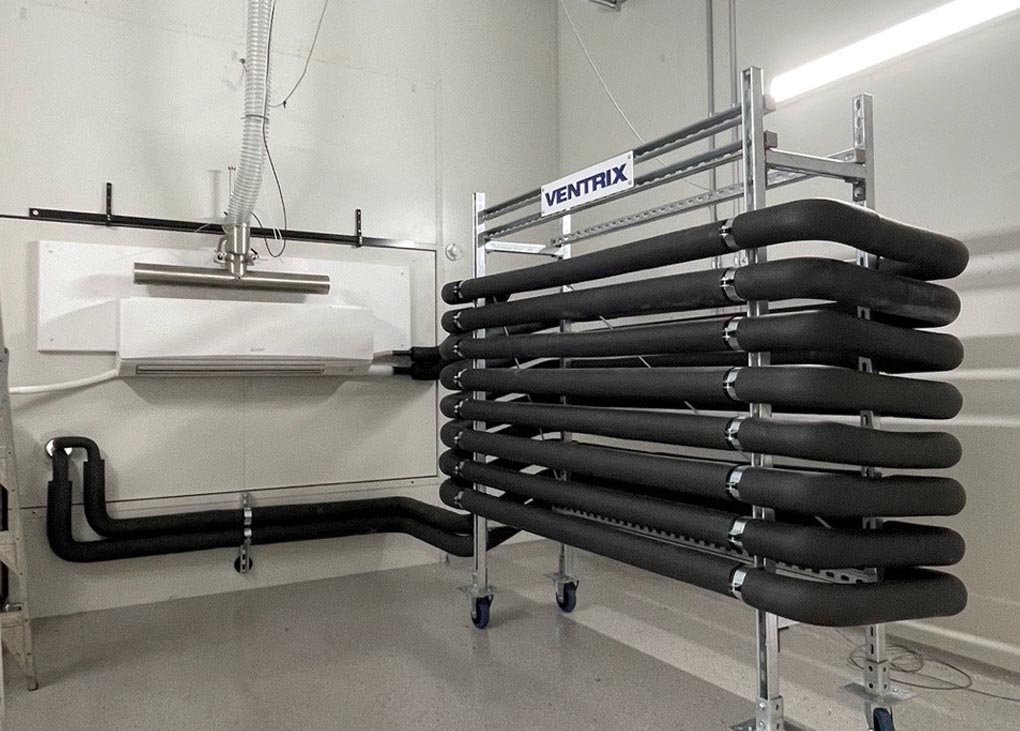Tests conducted by a specialist refrigeration piping contractor have confirmed negligible energy benefits from using higher R-value – and thicker – insulation on refrigeration pipework for air conditioning systems. As a result, industry stakeholders are now calling for a revision of the relevant section of the National Construction Code (NCC) to address the issues associated with the excess insulation.
Currently, to comply with NCC 2019 clause J5.8(a), refrigeration pipework requires a layer of insulation up to R1.7 – up to 38mm thick. This has a number of implications including:
- Increased labour costs – up to three workers are required to put the insulation in place, and it can take three times as long as installing thinner insulation
- Damage to smaller diameter tube when putting the thicker insulation in place
- The need for closer pipe support intervals to carry extra weight and prevent services from sagging
- Fire rating concerns
- Space constraints in ceilings and around equipment
- Greater embodied energy required to produce, store and transport the thicker insulation.
All of this is reflected in inflated project costs. It is estimated that contract value for clients is increased by as much as 35 per cent.
Questions were raised when the insulation requirements were first introduced in NCC 2019, but until now, there has been no conclusive data about their effectiveness. To provide industry with that data, Ventrix commissioned Vipac Engineers & Scientists to conduct comparison testing between different insulation sizes covering the interconnecting pipework of an air conditioning system. The tests were designed with input from a range of industry stakeholders, and carried out in a NATA-certified facility in general accordance with AS/NZS 3823.1.1:2012 and Determination 2019.
They included a 7.1kW high-wall split system with a variable speed compressor and a 50m pipe run in a balanced ambient calorimeter chamber using 38mm, 32mm, 25mm, 19mm, 13mm and no insulation in both heating and cooling modes. The tests measured the impact of the different insulation thicknesses on energy efficiency, capacity and power input.
In cooling mode, the reduction in energy efficiency ratio (EER) between 38mm insulation and 13mm insulation was found to be 0.42 per cent.
In heating mode, the reduction in coefficient of performance (COP) between 38mm insulation and 13mm insulation was found to be 0.72 per cent.
Between all sizes of insulation in both heating and cooling, the differences were well within margins of error.
“These results speak for themselves and hopefully will be used to confidently to move the requirement to reasonable parameters,” says Ventrix owner Andrew Markopoulos.
Given the significant costs – environmental and financial – of using thicker insulation, and the minimal improvement in performance, there have been renewed calls to revise the provision.
The NCC can be revised during the usual update process, but the next version will not be adopted until 2025.
Another option would be for practitioners to use the test data to develop performance solutions. But for smaller projects, the cost of doing this would be prohibitive.
A final possibility would be for an out-of-cycle change to the code. Industry stakeholders are currently communicating with the Australian Building Codes Board (ABCB) to investigate this option.
In terms of how this will affect industry, Markopoulos says: “While this test has produced results that clearly back countless performance solutions in this area and prove the need to review the current NCC, I’m hoping the ABCB can use this example to justify funding to allow them to carry out more testing, where they as well as industry believe it necessary, to help alleviate future flaws in the Australian building code.”
More information on the test results is available directly from Andrew Markopoulos: [email protected]



Leave a Reply